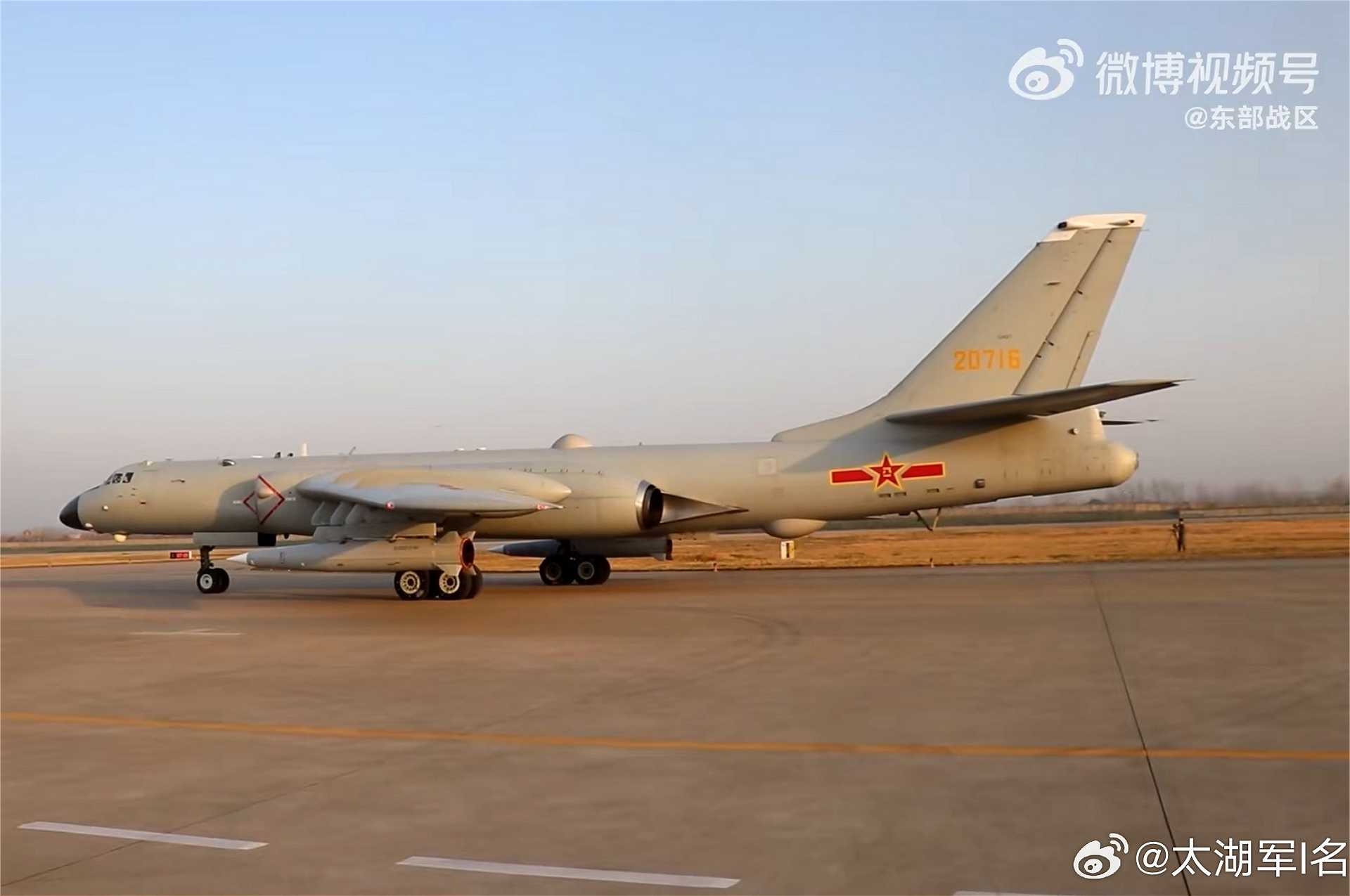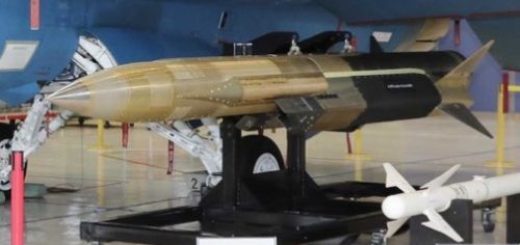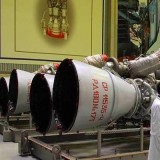Exclusive: China’s H-6K Bomber Debuts with KD-21 Hypersonic Ballistic Missiles in Historic First

{loadposition bannertop}
{loadposition sidebarpub}
Recent images have surfaced on Chinese social network showing a Xi’an H-6K bomber aircraft of the People’s Liberation Army Air Force (PLAAF), specifically from the 10th Bomber Division, carrying two KD-21 air-launched ballistic missiles (ALBMs) during an ongoing military exercise. This marks the first confirmed instance of an operational bomber being equipped with the KD-21 ballistic missile, underscoring a notable advancement in China’s aerial strike potential.Follow Army Recognition on Google News at this link
A Chinese Air Force H-6K bomber of the 10th Bomber Division seen for the first time carrying two KD-21 air-launched ballistic missiles during a live exercise, marking the operational debut of this advanced hypersonic-capable weapon system. (Picture source: Chinese Social Network)
The 10th Bomber Division is one of the oldest and most prestigious units in the PLAAF (People’s Liberation Chinese Air Force), established on January 17, 1951. Originally organized with the 28th, 29th, and 30th Bomber Regiments, it has been recognized with honorary titles such as “Model Bomber Group” and “Red Banner Division” for its outstanding service. The division now operates under the Eastern Theater Command Air Force, focusing on missions across the East China Sea and in proximity to Taiwan. Its main headquarters is located at Anqing Air Base in Anhui Province, with additional operations conducted from Luhe Air Base in Jiangsu Province. The division has played a vital role in enhancing China’s long-range air strike capability, often participating in strategic patrols and high-profile joint exercises. The involvement of the 10th Bomber Division in deploying the KD-21 missile further illustrates its role as a key platform for integrating new-generation weapon systems into operational use.
The H-6K, the platform now confirmed to be carrying the KD-21, is a modernized version of the original H-6 bomber, derived from the Soviet Tupolev Tu-16. The H-6K features extensive upgrades, including Russian-made D-30KP2 turbofan engines for increased fuel efficiency and range, a modernized cockpit with advanced avionics, and a restructured airframe with composite materials to reduce weight. These improvements grant the aircraft a combat radius of approximately 3,500 kilometers, allowing it to operate effectively over long distances and support China’s regional and strategic ambitions.
The KD-21 air-launched ballistic missile is a relatively new weapon in China’s arsenal, first revealed to the public during Airshow China 2022. It is believed to be derived from either the YJ-21 or CM-401 anti-ship ballistic missile, both of which are designed to strike high-value targets with high precision at very high speeds. The KD-21 is thought to be capable of reaching hypersonic speeds, potentially between Mach 4 and Mach 6, and may have an effective range of up to 1,500 kilometers depending on launch conditions. It is designed with advanced guidance systems for targeting both land and maritime assets, providing strategic flexibility in a variety of combat scenarios.
A unique feature of this missile is that a single H-6K bomber can reportedly carry up to four KD-21 missiles simultaneously, significantly multiplying the bomber’s strike capability in a single sortie. The air-launched deployment of such ballistic missiles introduces a new layer of complexity for enemy air defenses, as these weapons can be launched from variable locations and unpredictable vectors.
This exercise marks the first visual confirmation that the KD-21 has moved beyond prototype or trial phases and has now been integrated into frontline bomber operations. The appearance of two KD-21 missiles under the wings of an H-6K from the 10th Bomber Division signals that this advanced missile system is now in active service, dramatically expanding the strike envelope of China’s bomber force. The event also illustrates China’s increasing ability to deploy ALBMs—typically difficult to intercept due to their high speed and flight profiles—across wide operational ranges.
The strategic implications of this capability are substantial. The pairing of the H-6K with the KD-21 provides the PLAAF with a more dynamic, long-range precision strike platform, reducing dependency on ground-based missile forces and enhancing air-based deterrence. This development not only increases China’s flexibility in military operations but also elevates the threat level for adversaries operating in contested zones like the South China Sea and the Taiwan Strait.
For the United States and other countries, the operational deployment of the KD-21 represents a new and serious threat. U.S. bases in the Pacific region—including Guam, Okinawa, and even further inland locations—are now potentially within reach of Chinese bombers armed with ALBMs. These missiles can be launched from outside traditional defensive envelopes, making them much harder to intercept. Naval assets, particularly aircraft carrier strike groups operating in the Western Pacific, also face a heightened risk, as the KD-21 adds an airborne dimension to China’s anti-access/area denial (A2/AD) strategy. The increased strike radius and unpredictability of airborne missile platforms complicate the planning and execution of forward deployments and regional deterrence missions.
This development also reflects the rapid acceleration of China’s defense industrial base, particularly in the field of air-launched weapon systems and hypersonic missile technology. The PLAAF’s integration of the KD-21 is part of a broader trend in which Chinese aerospace firms, often state-supported, are delivering increasingly advanced systems at a faster pace. The combination of a maturing bomber fleet and cutting-edge missile systems places China in a more assertive strategic position, with the capability to challenge U.S. dominance in the Indo-Pacific and potentially project power even further afield.
The debut of the KD-21 air-launched ballistic missile on an operational H-6K bomber from the 10th Bomber Division is a significant milestone in China’s military modernization. It not only enhances the PLAAF’s long-range strike capabilities but also signals an urgent need for regional actors and global powers to reassess strategic calculations in light of China’s advancing aerospace and missile technologies. As China’s defense industry continues to accelerate, developments like the KD-21 will increasingly shape the strategic balance in the years ahead.

{loadposition bannertop}
{loadposition sidebarpub}
Recent images have surfaced on Chinese social network showing a Xi’an H-6K bomber aircraft of the People’s Liberation Army Air Force (PLAAF), specifically from the 10th Bomber Division, carrying two KD-21 air-launched ballistic missiles (ALBMs) during an ongoing military exercise. This marks the first confirmed instance of an operational bomber being equipped with the KD-21 ballistic missile, underscoring a notable advancement in China’s aerial strike potential.
Follow Army Recognition on Google News at this link
A Chinese Air Force H-6K bomber of the 10th Bomber Division seen for the first time carrying two KD-21 air-launched ballistic missiles during a live exercise, marking the operational debut of this advanced hypersonic-capable weapon system. (Picture source: Chinese Social Network)
The 10th Bomber Division is one of the oldest and most prestigious units in the PLAAF (People’s Liberation Chinese Air Force), established on January 17, 1951. Originally organized with the 28th, 29th, and 30th Bomber Regiments, it has been recognized with honorary titles such as “Model Bomber Group” and “Red Banner Division” for its outstanding service. The division now operates under the Eastern Theater Command Air Force, focusing on missions across the East China Sea and in proximity to Taiwan. Its main headquarters is located at Anqing Air Base in Anhui Province, with additional operations conducted from Luhe Air Base in Jiangsu Province. The division has played a vital role in enhancing China’s long-range air strike capability, often participating in strategic patrols and high-profile joint exercises. The involvement of the 10th Bomber Division in deploying the KD-21 missile further illustrates its role as a key platform for integrating new-generation weapon systems into operational use.
The H-6K, the platform now confirmed to be carrying the KD-21, is a modernized version of the original H-6 bomber, derived from the Soviet Tupolev Tu-16. The H-6K features extensive upgrades, including Russian-made D-30KP2 turbofan engines for increased fuel efficiency and range, a modernized cockpit with advanced avionics, and a restructured airframe with composite materials to reduce weight. These improvements grant the aircraft a combat radius of approximately 3,500 kilometers, allowing it to operate effectively over long distances and support China’s regional and strategic ambitions.
The KD-21 air-launched ballistic missile is a relatively new weapon in China’s arsenal, first revealed to the public during Airshow China 2022. It is believed to be derived from either the YJ-21 or CM-401 anti-ship ballistic missile, both of which are designed to strike high-value targets with high precision at very high speeds. The KD-21 is thought to be capable of reaching hypersonic speeds, potentially between Mach 4 and Mach 6, and may have an effective range of up to 1,500 kilometers depending on launch conditions. It is designed with advanced guidance systems for targeting both land and maritime assets, providing strategic flexibility in a variety of combat scenarios.
A unique feature of this missile is that a single H-6K bomber can reportedly carry up to four KD-21 missiles simultaneously, significantly multiplying the bomber’s strike capability in a single sortie. The air-launched deployment of such ballistic missiles introduces a new layer of complexity for enemy air defenses, as these weapons can be launched from variable locations and unpredictable vectors.
This exercise marks the first visual confirmation that the KD-21 has moved beyond prototype or trial phases and has now been integrated into frontline bomber operations. The appearance of two KD-21 missiles under the wings of an H-6K from the 10th Bomber Division signals that this advanced missile system is now in active service, dramatically expanding the strike envelope of China’s bomber force. The event also illustrates China’s increasing ability to deploy ALBMs—typically difficult to intercept due to their high speed and flight profiles—across wide operational ranges.
The strategic implications of this capability are substantial. The pairing of the H-6K with the KD-21 provides the PLAAF with a more dynamic, long-range precision strike platform, reducing dependency on ground-based missile forces and enhancing air-based deterrence. This development not only increases China’s flexibility in military operations but also elevates the threat level for adversaries operating in contested zones like the South China Sea and the Taiwan Strait.
For the United States and other countries, the operational deployment of the KD-21 represents a new and serious threat. U.S. bases in the Pacific region—including Guam, Okinawa, and even further inland locations—are now potentially within reach of Chinese bombers armed with ALBMs. These missiles can be launched from outside traditional defensive envelopes, making them much harder to intercept. Naval assets, particularly aircraft carrier strike groups operating in the Western Pacific, also face a heightened risk, as the KD-21 adds an airborne dimension to China’s anti-access/area denial (A2/AD) strategy. The increased strike radius and unpredictability of airborne missile platforms complicate the planning and execution of forward deployments and regional deterrence missions.
This development also reflects the rapid acceleration of China’s defense industrial base, particularly in the field of air-launched weapon systems and hypersonic missile technology. The PLAAF’s integration of the KD-21 is part of a broader trend in which Chinese aerospace firms, often state-supported, are delivering increasingly advanced systems at a faster pace. The combination of a maturing bomber fleet and cutting-edge missile systems places China in a more assertive strategic position, with the capability to challenge U.S. dominance in the Indo-Pacific and potentially project power even further afield.
The debut of the KD-21 air-launched ballistic missile on an operational H-6K bomber from the 10th Bomber Division is a significant milestone in China’s military modernization. It not only enhances the PLAAF’s long-range strike capabilities but also signals an urgent need for regional actors and global powers to reassess strategic calculations in light of China’s advancing aerospace and missile technologies. As China’s defense industry continues to accelerate, developments like the KD-21 will increasingly shape the strategic balance in the years ahead.






